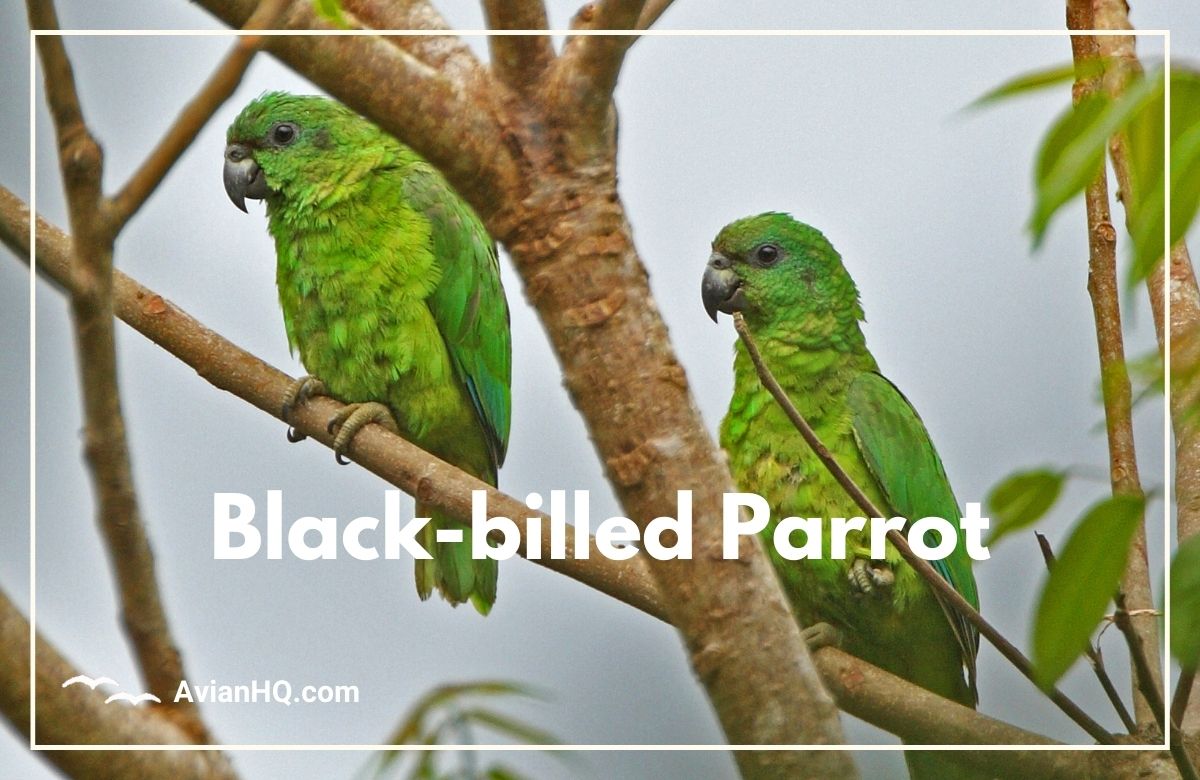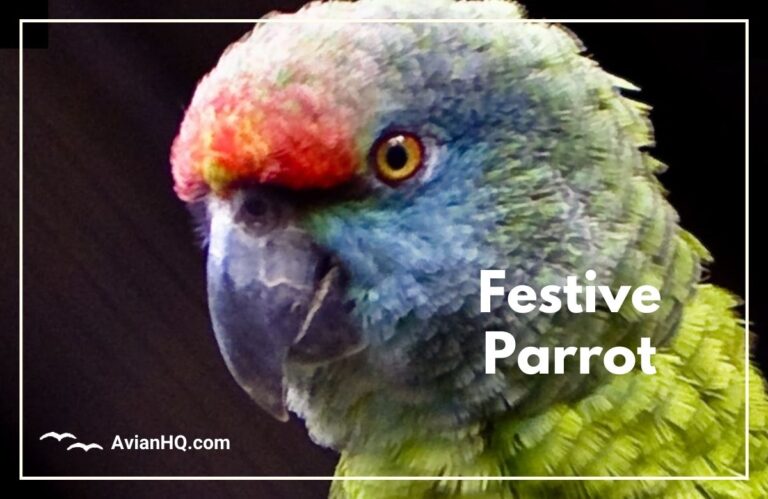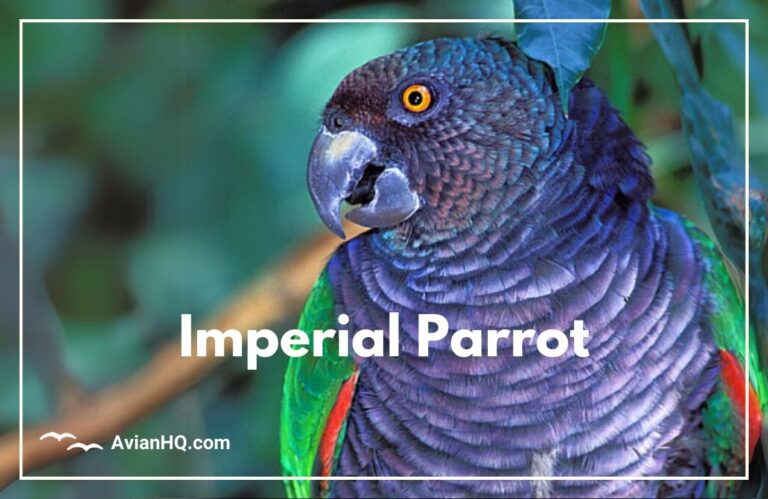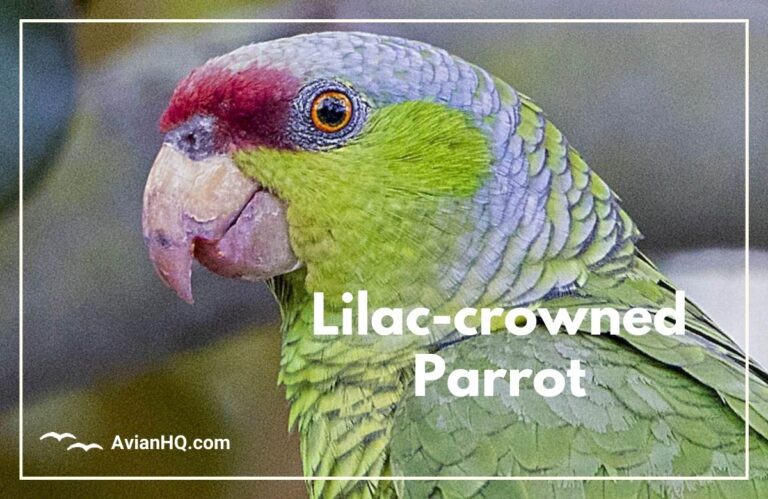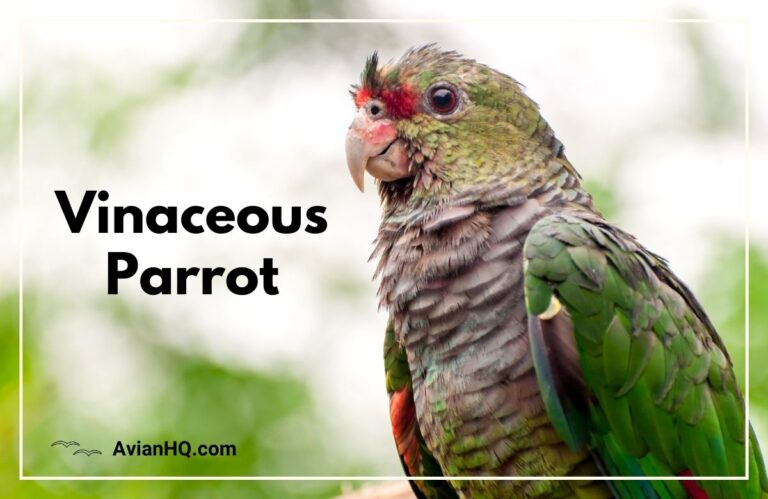Black-billed Parrot (Amazona agilis)
You gaze up into the rainforest canopy searching for a flash of green feathers and a peek at Jamaica’s endemic Black-billed Parrot. A high-pitched squawk catches your attention as a flock bursts from the trees, their bright red and blue wing patches flashing in the sunlight. Weighing about half a pound (230 grams), these small, nimble parrots live up to their scientific name Amazona agilis, meaning “active amazon”.
As the parrots chatter and swoop through the air, you catch a glimpse of their distinctive dark grey bills, unlike the yellow bills of their close relative, the Yellow-billed Amazon. The Black-billed Parrot, sometimes called the Black-billed Amazon, is Jamaica’s only endemic parrot species. Sadly, this rare tropical bird faces threats from habitat loss and climate change. However, conservation efforts aim to protect remaining populations.
“The Black-billed Parrot’s high-pitched squawks reveal its presence long before you spot one of these island endemics.”
You’ll need to venture into rugged terrain like Jamaica’s Cockpit Country or the Blue Mountains to find Black-billed Parrots foraging in small flocks high in the forest canopy. Read on to learn more about:
- Identifying these colorful island parrots
- The critical habitat they depend on
- Their unique behaviors and loud calls
- Threats from deforestation and hurricanes
- Conservation efforts needed to protect them
Understanding more about this Vulnerable species can help ensure Jamaica retains its full complement of native parrots for future generations. Watching a flock of Black-billed Parrots chatter and preen like feathered acrobats provides just one example of this island’s rich biodiversity worth protecting.
History and Taxonomy Reveal an Overlooked Parrot
The Black-billed Parrot remained unknown to science until the mid-1700s, escaping notice due to its small size and remote forest home. Not until 1751 did English naturalist George Edwards first describe the species from a live specimen, calling it “The little green parrot” and assuming a West Indian origin. Edwards commissioned an exquisite hand-colored etching of the parrot, its subtle red and blue wing patches meticulously detailed.
Swedish taxonomist Carl Linnaeus then provided the first scientific name for the species in 1758, classifying it as Psittacus agilis and coining the enduring species epithet agilis meaning “active” or “agile”. Today, ornithologists place this species in its own genus, Amazona, Latin for “amazon”, reserved for the New World parrots. No recognized subspecies of the Black-billed Parrot exist.
Weighing only about half a pound (230 grams), the Black-billed Parrot measures just 10-11 inches long (25-27 cm). Its dark gray bill distinguishes it from the larger Yellow-billed Amazon. Sadly, habitat loss has made the Black-billed Parrot much rarer today compared to its close cousin. Protecting sufficient old-growth rainforest habitat remains key to ensuring this diminutive parrot’s future.
Physical Appearance
The Black-billed Parrot’s bright green plumage allows it to blend into rainforest foliage, while also boasting colorful flashes of red, blue, and yellow. Its body feathers sport primarily green hues, ranging from darker emerald on the back to paler yellow-green underparts. The neck feathers have soft dusky edges, while the wings and tail reveal the parrot’s more dazzling shades.
Male and female plumage differs slightly. Males have vivid red wing patches formed by their red primary coverts. Females lack much of this red, their coverts remaining mostly green. Both sexes share striking blue primary and secondary flight feathers, along with blue-edged outer tail feathers. These blue shades appear deeper than those found on their Yellow-billed cousin.
When perched, the parrot’s subtly-colored plumage provides camouflage. But when exhibiting display behaviors or bursting into flight, sudden flourishes of red, blue and green signal an acrobat lies hidden in the greenery!
Key Physical Traits:
- Size: 10-11 inches long (25-27 cm); weighs approx. half a pound (230 grams)
- Plumage: Mostly green with yellow-green underparts, red & blue wing patches, blue-edged tail feathers
- Bill: Distinctive dark grey bill unlike yellow bill of its Amazon cousin
The Black-billed Parrot’s specially adapted feet, bill, and colorful vision reveal an agile tree-dweller optimized for an arboreal life harvesting fruit and nuts. Protecting stretches of old-growth rainforest helps ensure this tropical acrobat retains access to the mature trees and food sources it depends on.
Habitat and Distribution
The Black-billed Parrot clings to survival in Jamaica’s rugged interior mountains, found only on its home island. This Vulnerable species remains restricted to two primary strongholds: the remote Cockpit Country and the Blue and John Crow Mountains in eastern Jamaica.
These areas harbor critical wet limestone forest habitat, with a hot and humid climate and limestone-rich soils. Black-billed Parrots inhabit elevations between approximately 1000-4000 feet (300-1200 meters). They occasionally wander outside these core habitats, sometimes appearing in rural areas or the outskirts of Kingston. But any flock sighted away from western or eastern mountain refuges likely represents wayward migrants rather than an established population.
Protecting sufficient intact rainforest remains vital for these site-endemic parrots. However, expanding agriculture and logging steadily eat away at suitable habitat. Meanwhile, the parrots must also adapt to hazards ranging from destructive hurricanes to competition with invasive bird species. Meeting the Black-billed Parrot’s specialized habitat needs poses a conservation challenge requiring action on multiple fronts.
Key Habitat Features:
- Endemic to Jamaica
- Inhabits 2 primary strongholds:
- Cockpit Country
- Blue & John Crow Mountains
- Elevation: 1000-4000 ft (300-1200 m)
- Climate: Wet limestone forests
Diet and Feeding
The Black-billed Parrot’s strong bills and agile nature allow them to harvest a diverse diet from rainforest trees. Feeding high in the canopy, flocks forage on a variety of fruits, seeds, nuts, and even leaf buds and blossoms. Their varied vegetarian menu provides balanced nutrition while helping propagate their forest home.
Wild fruits the parrots enjoy include ripe bananas, papayas, figs, and cecropia. Trees like the Antillean sweetwood provide nourishment in the form of seeds enclosed in leathery reddish-brown pods. High in nutrition, these oily seeds likely help sustain the parrots through hurricanes and other lean times.
The parrots use their specialized bills like a Swiss Army knife – crushing hard nuts, extracting seeds, harvesting buds, and more. Their dexterous toes also help them cling to branches while feeding. Protecting stands of native fruit and nut-bearing trees remains essential to safeguard food sources these island endemics rely on.
Key Dietary Features:
- Mostly herbivorous
- Consumes fruits, seeds, nuts, leaf buds, blossoms
- Feeds on canopy trees like fig, cecropia, & Antillean sweetwood
- Uses specialized bill to process diverse foods
- Forages in small flocks
The Black-billed Parrot’s varied wild diet proves largely irreplaceable for captive specimens. Careful research on rainforest flora helps provide suitable fruits and vegetables in human care. But nothing fully substitutes for the diversity of foods a flock harvests fluttering through its island home. Protecting Jamaica’s endemic parrots means protecting stretches of forest flush with their favorite native foods.
Breeding and Reproduction
The Black-billed Parrot’s breeding behaviors remain poorly documented, with nesting concealed in rugged habitat. But observations reveal preferences for tree hollows and woodpecker cavities located high in the rainforest canopy.
Breeding season falls between March and July. Pairs produce typical clutch sizes of 3-4 eggs. The parents incubate these small white eggs for around 26 days before naked, helpless chicks hatch. Fledging occurs at approximately 8 weeks, producing fully feathered juvenile parrots ready to join flocks.
Throughout this process the parents remain vigilant against predators. Native rainforest-dwellers like the Jamaican boa snake raid unattended nests. Invasive species like rats and feral cats may also threaten breeding success. Protecting intact canopy trees with suitable nesting holes could help counter declining populations. Hand-rearing captive chicks rescued from fallen nests provides another alternative.
Key Breeding Traits:
- Season: March to July
- Clutch: Usually 3-4 eggs
- Incubation: Approximately 26 days
- Fledging Age: Around 8 weeks
- Nest Sites: Tree hollows & woodpecker cavities high in canopy
Ensuring the survival of each new generation proves critical for Vulnerable species like the Black-billed Parrot. While much remains unknown about their secretive breeding habits, evidence shows nesting occurs in mature rainforest trees. Conserving sufficiently large habitat stretches to support viable breeding populations gives Jamaica the best chance of retaining its sole endemic parrot long term.
Behavior and Ecology
Vocal, tight-knit flocks of Black-billed Parrots chatter and shriek as they harvest fruits and seeds high in Jamaica’s rainforest canopy. But don’t let the energetic gatherings fool you. This Vulnerable species’ total population likely does not exceed 15,000 birds. Deforestation and climate change impacts continue to threaten numbers.
Typical flocks contain 6-40 brightly plumed members. They communally roost in trees overnight, departing at sunrise in raucous groups to forage. The parrots exhibit loyalty to home ranges, only wandering locally when searching for ripened foods. Their high-pitched squawks and screeches reveal a gathering long before human eyes spot one.
These behaviors showcase complex social dynamics akin to those of monkeys, their fellow canopy denizens. Protecting flock habitat means preserving not just nesting sites but also adequate food resources and roosting trees. Fragmented forests may fail to support the intact, vigorous flocks vital to long-term genetic diversity.
Key Behavioral Traits:
- Social, tight-knit flocks
- 6-40 members on average
- Loyal to home ranges
- Loud, high-pitched vocalizations
- Complex behaviors and interactions
Despite their bold behaviors, Black-billed Parrots remain one of Jamaica’s most threatened endemic species. Safeguarding behaviors closely tied to specialized forest habitats poses a significant conservation challenge. But helping fragile flocks continue their boisterous ways also promises to benefit entire rainforest ecosystems.
Conservation Status
The Black-billed Parrot’s limited island distribution and small global population have led the IUCN Red List to categorize it as Vulnerable. Continued habitat loss coupled with threats ranging from the pet trade to extreme weather events have caused the species to decline over decades. However, recent population estimates remain uncertain. Surveys indicate between 6,000-15,000 individuals likely persist in the wild.
The remote and rugged terrain the parrots inhabit complicates monitoring efforts. But their extinction would mean Jamaica loses its only endemic parrot species. Protecting sufficient intact rainforest across multiple habitat blocks remains key to safeguarding a viable breeding population. Listing the Black-billed Parrot under CITES Appendix II also helps regulate and track any international trade.
Ongoing conservation projects aim to better estimate population sizes and trends. Proposed protected habitat and captive breeding initiatives may also boost the species’ chance of survival. However, threats continue on multiple fronts. Preventing this diminutive, uniquely Jamaican parrot from slipping closer to extinction will require prolonged, coordinated action across constituencies.
Conservation Status:
- IUCN Red List: Vulnerable
- Population Estimate: 6,000-15,000
- CITES: Appendix II
If the last Black-billed Parrot uttered its final high-pitched cry, Jamaica would lose more than its sole endemic parrot. The island would lose an integral thread in its rainforest tapestry, one helping uphold a vibrant ecosystem. Conserving this species conserves far more than a distinctive dark-billed psittacine. It conserves Jamaica’s natural heritage.
Cultural Significance
The Black-billed Parrot holds a special place in Jamaica’s cultural fabric and history. These birds likely inhabited the island for millennia before human settlement, playing integral ecological roles. The parrot’s extinction would tear an irreparable hole in the tapestry of Jamaican wildlife.
Fossil records indicate that various Amazona parrots populated the Caribbean long before humans arrived. Indigenous Jamaican cultures such as the Taino may have incorporated these brightly plumed birds into spiritual beliefs or legends. However, any folklore remains unrecorded today.
During the age of European colonialism, many exotic bird species captured the fascination of naturalists and aristocrats. Vibrantly illustrated tomes helped introduce the Black-billed Parrot to the western world. But even centuries ago, habitat loss threatenedwild populations enough to warrant the species’ modern endangered status.
Protecting the beloved Black-billed Parrot now requires the shared commitment of Jamaicans from many walks of life. From conservationists to policy-makers to residents of rural communities, united dedication to preserving native habitat can help safeguard this cultural heritage. Though threats loom, focused action still promises hope.
Key Cultural Roles:
- Likely inhabited Jamaica for millennia
- May hold significance in indigenous folklore
- Helped introduce Jamaica’s wildlife to Europe
- Remains an iconic & cherished endemic
By conserving the Black-billed Parrot, Jamaicans conserve part of their national identity – one worth preserving for future generations. Though small, this vulnerable parrot represents the island itself: resilient, lively, colored with heritage, and still persevering.
Conclusion
The Black-billed Parrot remains not only Jamaica’s sole endemic parrot, but a vulnerable species racing against threats on multiple fronts. From habitat loss to climate change, confronting the challenges requires coordinated action across constituencies to preserve this island treasure.
As an umbrella species closely tied to rainforest ecosystems, protecting the black-billed parrot ultimately helps conserve Jamaica’s rich biodiversity as a whole. Safeguarding parrot strongholds allows entire canopy communities to thrive – from mountain black snakes to giant swallowtail butterflies to fruit bats. Strengthening environmental policies, expanding protected areas, and increasing global awareness complement on-the-ground forest restoration and population monitoring.
While less than 15,000 Black-billed Parrots likely persist in the wild, well-planned conservation initiatives can still make a difference. And you can help by supporting non-profits working to protect Jamaican species. Visiting the island and contributing tourist dollars to sustainable sites also empowers local communities to become stewards of their natural heritage.
Racing the extinction clock requires urgent action on many fronts. But it starts with valuing the Black-billed Parrot as the irreplaceable endemic treasure it is. By appreciating and conserving this small parrot, the world ultimately helps Jamaica conserve vibrant stretches of rainforest that nourish both wildlife and local people. And that benefits the entire Caribbean and beyond.
Key Takeaways:
- Jamaican endemic racing against extinction
- Umbrella species – protecting it aids broader rainforest biodiversity
- Supports coordinated policies and on-the-ground action
- Eco-tourism and charity aid conservation initiatives
- Valuing the parrot protects Jamaica’s natural heritage
The time to act is now. The Black-billed Parrot clings to survival in its island home. You can help ensure this diminutive Caribbean jewel continues charming future generations with its high-pitched cries echoing through Jamaica’s forests.

